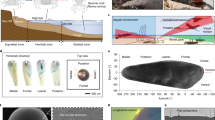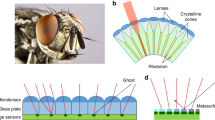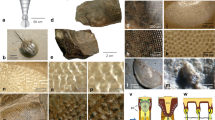Abstract
THE compound eyes of many marine and some terrestrial arthropods have smooth surfaces with no convex curvature to the facets. This means that image formation by ordinary spherical refraction is impossible. Nevertheless, apposition eyes of this kind form images behind each surface facet1,2 (Fig. 1b) and the question has repeatedly arisen as to how these images are produced. Exner chose the king crab, Limulus, as providing the definitive example of such an eye, and from a mixture of observation and theory came up with the idea of a lens-cylinder, a flat-ended optical device in which the refractive index decreases from the central axis to the periphery in a roughly parabolic manner1. This arrangement will form an image (Fig. 2a), and devices of this kind have actually been manufactured3,4. Exner's theory has long been considered to be the correct account of image formation in this type of eye5. However, Levi-Setti, Park and Winston2 have recently produced a fundamentally different explanation of image formation in Limulus eyes (Fig. 2b). This was based on the idea that each optical element, or crystalline cone, concentrated light by reflection, not refraction, and that it was the shape of the crystalline cone's reflective surface, and not its internal refractive index gradient, that led to the image-forming properties of the structure. This principle had already been used in another optical device, the ‘ideal light collector’ (ref. 6) which was invented as a tool for concentrating faint radiation. In this report I discuss the two suggested optical mechanisms for the eye of Limulus, and present evidence from interference microscopy that Exner's theory is probably the correct one.
This is a preview of subscription content, access via your institution
Access options
Subscribe to this journal
Receive 51 print issues and online access
$199.00 per year
only $3.90 per issue
Buy this article
- Purchase on Springer Link
- Instant access to full article PDF
Prices may be subject to local taxes which are calculated during checkout
Similar content being viewed by others
References
Exner, S. Die Physiologie der facettierten Augen von Krebsen and Insecten (Leipzig, Deuticke, 1891).
Levi-Setti, R., Park, D. A. & Winston, R. Nature 253, 115–116 (1975).
Ohtsuka, Y. Appl. Phys. Lett. 23, 247–248 (1973).
Iga, K. & Yamamoto, N. Appl. Opt. 16, 1305–1310 (1977).
Kirschfeld, K. in Processing of Optical Data by Organisms and by Machines (ed. Reichardt, W.) 114–166 (Academic, New York, 1969).
Winston, R. J. opt. Soc. Am. 60, 245–247 (1970).
Fletcher, A., Murphy, T. & Young, A. Proc. R. Soc. A223, 216–225 (1974).
Carracaburu, P. C. r. hebd. Séanc. Acad. Sci., Paris D264, 1476–1478 (1967).
Author information
Authors and Affiliations
Rights and permissions
About this article
Cite this article
LAND, M. The optical mechanism of the eye of Limulus. Nature 280, 396–397 (1979). https://doi.org/10.1038/280396a0
Received:
Accepted:
Published:
Issue Date:
DOI: https://doi.org/10.1038/280396a0
This article is cited by
-
The transparent compound eye ofHyperia (Crustacea): Examination with a new method for analysis of refractive index gradients
Journal of Comparative Physiology ? A (1982)
-
Optics of the eyes ofPhronima and other deep-sea amphipods
Journal of Comparative Physiology ? A (1981)
-
Compound eyes: old and new optical mechanisms
Nature (1980)
Comments
By submitting a comment you agree to abide by our Terms and Community Guidelines. If you find something abusive or that does not comply with our terms or guidelines please flag it as inappropriate.



